Runway Incursion Prevention Systems
VerifiedAdded on 2020/05/04
|19
|5534
|31
AI Summary
This assignment delves into the critical topic of runway incursion prevention. It requires students to analyze the various factors contributing to runway incursions, examine existing prevention systems like Runway Incursion Prevention Systems (RIPS), and assess their efficacy in enhancing aviation safety. The analysis should encompass human error, technological solutions, and regulatory frameworks aimed at mitigating this significant safety risk.
Contribute Materials
Your contribution can guide someone’s learning journey. Share your
documents today.
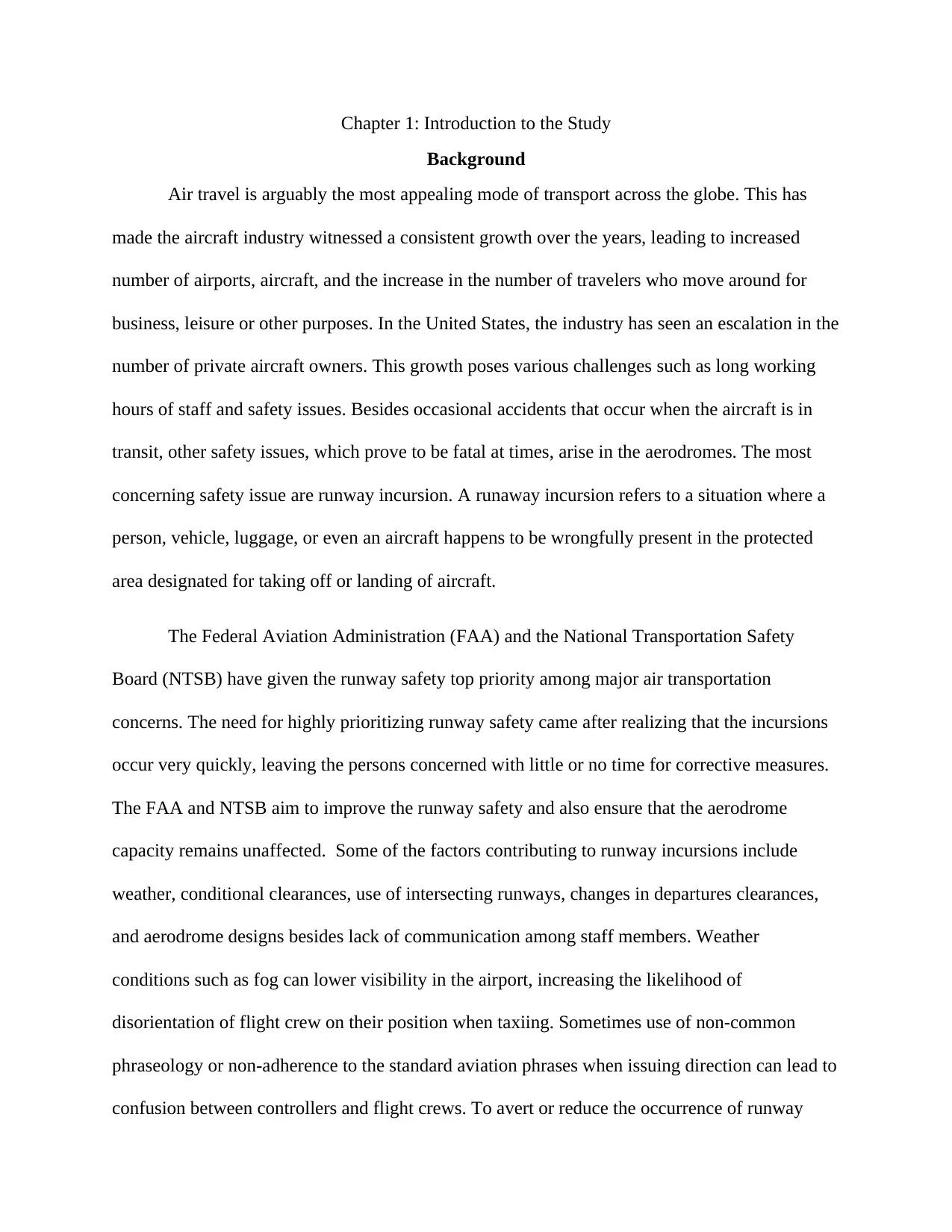
Chapter 1: Introduction to the Study
Background
Air travel is arguably the most appealing mode of transport across the globe. This has
made the aircraft industry witnessed a consistent growth over the years, leading to increased
number of airports, aircraft, and the increase in the number of travelers who move around for
business, leisure or other purposes. In the United States, the industry has seen an escalation in the
number of private aircraft owners. This growth poses various challenges such as long working
hours of staff and safety issues. Besides occasional accidents that occur when the aircraft is in
transit, other safety issues, which prove to be fatal at times, arise in the aerodromes. The most
concerning safety issue are runway incursion. A runaway incursion refers to a situation where a
person, vehicle, luggage, or even an aircraft happens to be wrongfully present in the protected
area designated for taking off or landing of aircraft.
The Federal Aviation Administration (FAA) and the National Transportation Safety
Board (NTSB) have given the runway safety top priority among major air transportation
concerns. The need for highly prioritizing runway safety came after realizing that the incursions
occur very quickly, leaving the persons concerned with little or no time for corrective measures.
The FAA and NTSB aim to improve the runway safety and also ensure that the aerodrome
capacity remains unaffected. Some of the factors contributing to runway incursions include
weather, conditional clearances, use of intersecting runways, changes in departures clearances,
and aerodrome designs besides lack of communication among staff members. Weather
conditions such as fog can lower visibility in the airport, increasing the likelihood of
disorientation of flight crew on their position when taxiing. Sometimes use of non-common
phraseology or non-adherence to the standard aviation phrases when issuing direction can lead to
confusion between controllers and flight crews. To avert or reduce the occurrence of runway
Background
Air travel is arguably the most appealing mode of transport across the globe. This has
made the aircraft industry witnessed a consistent growth over the years, leading to increased
number of airports, aircraft, and the increase in the number of travelers who move around for
business, leisure or other purposes. In the United States, the industry has seen an escalation in the
number of private aircraft owners. This growth poses various challenges such as long working
hours of staff and safety issues. Besides occasional accidents that occur when the aircraft is in
transit, other safety issues, which prove to be fatal at times, arise in the aerodromes. The most
concerning safety issue are runway incursion. A runaway incursion refers to a situation where a
person, vehicle, luggage, or even an aircraft happens to be wrongfully present in the protected
area designated for taking off or landing of aircraft.
The Federal Aviation Administration (FAA) and the National Transportation Safety
Board (NTSB) have given the runway safety top priority among major air transportation
concerns. The need for highly prioritizing runway safety came after realizing that the incursions
occur very quickly, leaving the persons concerned with little or no time for corrective measures.
The FAA and NTSB aim to improve the runway safety and also ensure that the aerodrome
capacity remains unaffected. Some of the factors contributing to runway incursions include
weather, conditional clearances, use of intersecting runways, changes in departures clearances,
and aerodrome designs besides lack of communication among staff members. Weather
conditions such as fog can lower visibility in the airport, increasing the likelihood of
disorientation of flight crew on their position when taxiing. Sometimes use of non-common
phraseology or non-adherence to the standard aviation phrases when issuing direction can lead to
confusion between controllers and flight crews. To avert or reduce the occurrence of runway
Secure Best Marks with AI Grader
Need help grading? Try our AI Grader for instant feedback on your assignments.
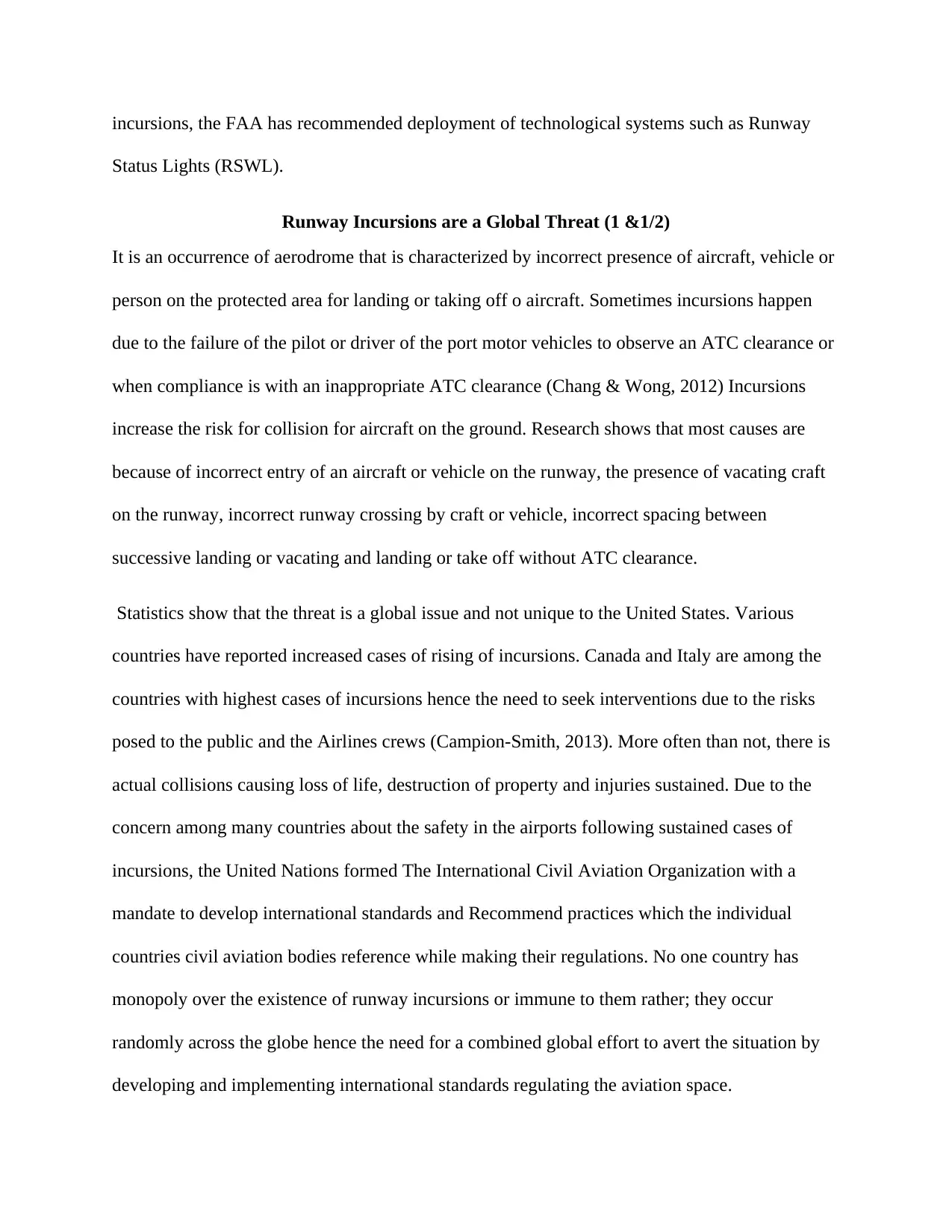
incursions, the FAA has recommended deployment of technological systems such as Runway
Status Lights (RSWL).
Runway Incursions are a Global Threat (1 &1/2)
It is an occurrence of aerodrome that is characterized by incorrect presence of aircraft, vehicle or
person on the protected area for landing or taking off o aircraft. Sometimes incursions happen
due to the failure of the pilot or driver of the port motor vehicles to observe an ATC clearance or
when compliance is with an inappropriate ATC clearance (Chang & Wong, 2012) Incursions
increase the risk for collision for aircraft on the ground. Research shows that most causes are
because of incorrect entry of an aircraft or vehicle on the runway, the presence of vacating craft
on the runway, incorrect runway crossing by craft or vehicle, incorrect spacing between
successive landing or vacating and landing or take off without ATC clearance.
Statistics show that the threat is a global issue and not unique to the United States. Various
countries have reported increased cases of rising of incursions. Canada and Italy are among the
countries with highest cases of incursions hence the need to seek interventions due to the risks
posed to the public and the Airlines crews (Campion-Smith, 2013). More often than not, there is
actual collisions causing loss of life, destruction of property and injuries sustained. Due to the
concern among many countries about the safety in the airports following sustained cases of
incursions, the United Nations formed The International Civil Aviation Organization with a
mandate to develop international standards and Recommend practices which the individual
countries civil aviation bodies reference while making their regulations. No one country has
monopoly over the existence of runway incursions or immune to them rather; they occur
randomly across the globe hence the need for a combined global effort to avert the situation by
developing and implementing international standards regulating the aviation space.
Status Lights (RSWL).
Runway Incursions are a Global Threat (1 &1/2)
It is an occurrence of aerodrome that is characterized by incorrect presence of aircraft, vehicle or
person on the protected area for landing or taking off o aircraft. Sometimes incursions happen
due to the failure of the pilot or driver of the port motor vehicles to observe an ATC clearance or
when compliance is with an inappropriate ATC clearance (Chang & Wong, 2012) Incursions
increase the risk for collision for aircraft on the ground. Research shows that most causes are
because of incorrect entry of an aircraft or vehicle on the runway, the presence of vacating craft
on the runway, incorrect runway crossing by craft or vehicle, incorrect spacing between
successive landing or vacating and landing or take off without ATC clearance.
Statistics show that the threat is a global issue and not unique to the United States. Various
countries have reported increased cases of rising of incursions. Canada and Italy are among the
countries with highest cases of incursions hence the need to seek interventions due to the risks
posed to the public and the Airlines crews (Campion-Smith, 2013). More often than not, there is
actual collisions causing loss of life, destruction of property and injuries sustained. Due to the
concern among many countries about the safety in the airports following sustained cases of
incursions, the United Nations formed The International Civil Aviation Organization with a
mandate to develop international standards and Recommend practices which the individual
countries civil aviation bodies reference while making their regulations. No one country has
monopoly over the existence of runway incursions or immune to them rather; they occur
randomly across the globe hence the need for a combined global effort to avert the situation by
developing and implementing international standards regulating the aviation space.
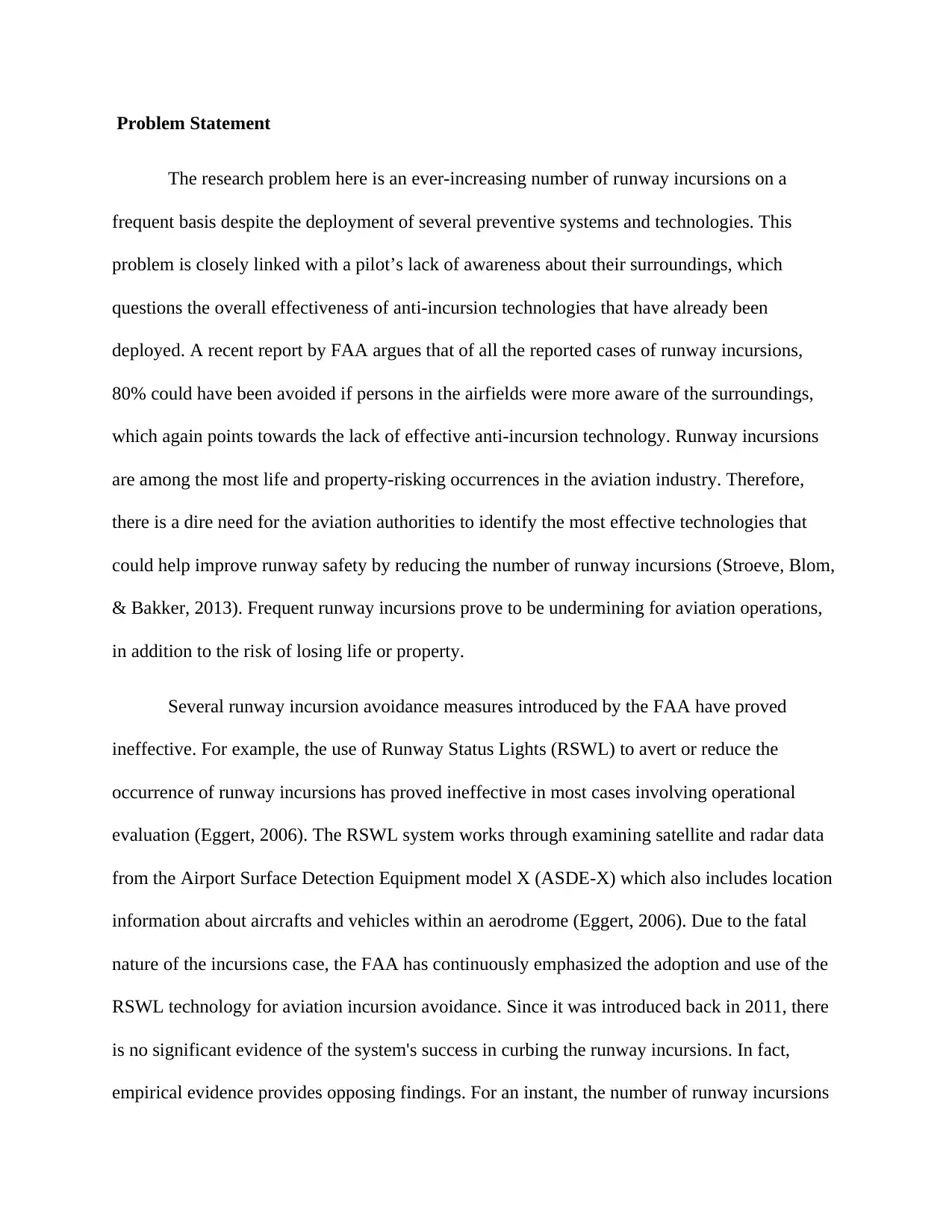
Problem Statement
The research problem here is an ever-increasing number of runway incursions on a
frequent basis despite the deployment of several preventive systems and technologies. This
problem is closely linked with a pilot’s lack of awareness about their surroundings, which
questions the overall effectiveness of anti-incursion technologies that have already been
deployed. A recent report by FAA argues that of all the reported cases of runway incursions,
80% could have been avoided if persons in the airfields were more aware of the surroundings,
which again points towards the lack of effective anti-incursion technology. Runway incursions
are among the most life and property-risking occurrences in the aviation industry. Therefore,
there is a dire need for the aviation authorities to identify the most effective technologies that
could help improve runway safety by reducing the number of runway incursions (Stroeve, Blom,
& Bakker, 2013). Frequent runway incursions prove to be undermining for aviation operations,
in addition to the risk of losing life or property.
Several runway incursion avoidance measures introduced by the FAA have proved
ineffective. For example, the use of Runway Status Lights (RSWL) to avert or reduce the
occurrence of runway incursions has proved ineffective in most cases involving operational
evaluation (Eggert, 2006). The RSWL system works through examining satellite and radar data
from the Airport Surface Detection Equipment model X (ASDE-X) which also includes location
information about aircrafts and vehicles within an aerodrome (Eggert, 2006). Due to the fatal
nature of the incursions case, the FAA has continuously emphasized the adoption and use of the
RSWL technology for aviation incursion avoidance. Since it was introduced back in 2011, there
is no significant evidence of the system's success in curbing the runway incursions. In fact,
empirical evidence provides opposing findings. For an instant, the number of runway incursions
The research problem here is an ever-increasing number of runway incursions on a
frequent basis despite the deployment of several preventive systems and technologies. This
problem is closely linked with a pilot’s lack of awareness about their surroundings, which
questions the overall effectiveness of anti-incursion technologies that have already been
deployed. A recent report by FAA argues that of all the reported cases of runway incursions,
80% could have been avoided if persons in the airfields were more aware of the surroundings,
which again points towards the lack of effective anti-incursion technology. Runway incursions
are among the most life and property-risking occurrences in the aviation industry. Therefore,
there is a dire need for the aviation authorities to identify the most effective technologies that
could help improve runway safety by reducing the number of runway incursions (Stroeve, Blom,
& Bakker, 2013). Frequent runway incursions prove to be undermining for aviation operations,
in addition to the risk of losing life or property.
Several runway incursion avoidance measures introduced by the FAA have proved
ineffective. For example, the use of Runway Status Lights (RSWL) to avert or reduce the
occurrence of runway incursions has proved ineffective in most cases involving operational
evaluation (Eggert, 2006). The RSWL system works through examining satellite and radar data
from the Airport Surface Detection Equipment model X (ASDE-X) which also includes location
information about aircrafts and vehicles within an aerodrome (Eggert, 2006). Due to the fatal
nature of the incursions case, the FAA has continuously emphasized the adoption and use of the
RSWL technology for aviation incursion avoidance. Since it was introduced back in 2011, there
is no significant evidence of the system's success in curbing the runway incursions. In fact,
empirical evidence provides opposing findings. For an instant, the number of runway incursions
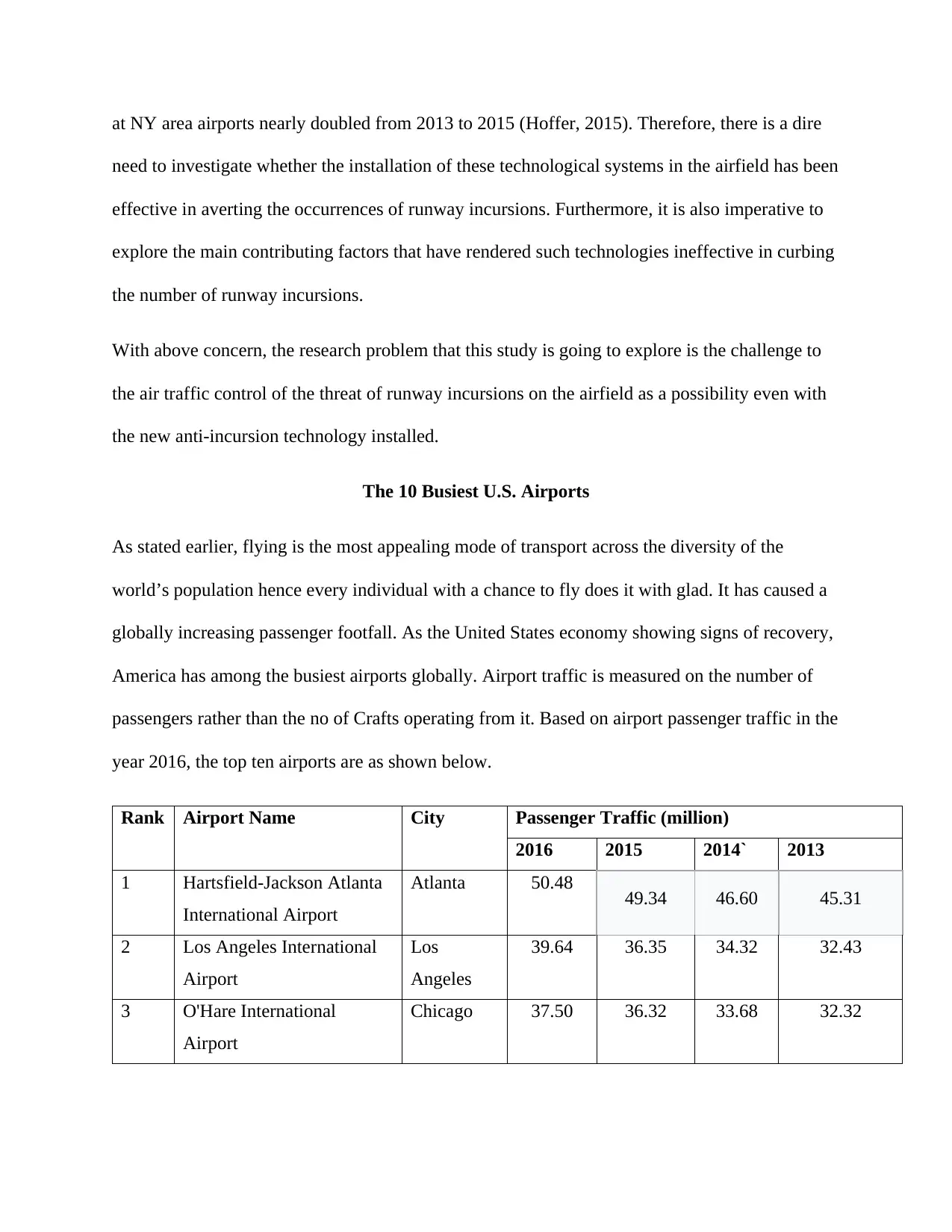
at NY area airports nearly doubled from 2013 to 2015 (Hoffer, 2015). Therefore, there is a dire
need to investigate whether the installation of these technological systems in the airfield has been
effective in averting the occurrences of runway incursions. Furthermore, it is also imperative to
explore the main contributing factors that have rendered such technologies ineffective in curbing
the number of runway incursions.
With above concern, the research problem that this study is going to explore is the challenge to
the air traffic control of the threat of runway incursions on the airfield as a possibility even with
the new anti-incursion technology installed.
The 10 Busiest U.S. Airports
As stated earlier, flying is the most appealing mode of transport across the diversity of the
world’s population hence every individual with a chance to fly does it with glad. It has caused a
globally increasing passenger footfall. As the United States economy showing signs of recovery,
America has among the busiest airports globally. Airport traffic is measured on the number of
passengers rather than the no of Crafts operating from it. Based on airport passenger traffic in the
year 2016, the top ten airports are as shown below.
Rank Airport Name City Passenger Traffic (million)
2016 2015 2014` 2013
1 Hartsfield-Jackson Atlanta
International Airport
Atlanta 50.48 49.34 46.60 45.31
2 Los Angeles International
Airport
Los
Angeles
39.64 36.35 34.32 32.43
3 O'Hare International
Airport
Chicago 37.50 36.32 33.68 32.32
need to investigate whether the installation of these technological systems in the airfield has been
effective in averting the occurrences of runway incursions. Furthermore, it is also imperative to
explore the main contributing factors that have rendered such technologies ineffective in curbing
the number of runway incursions.
With above concern, the research problem that this study is going to explore is the challenge to
the air traffic control of the threat of runway incursions on the airfield as a possibility even with
the new anti-incursion technology installed.
The 10 Busiest U.S. Airports
As stated earlier, flying is the most appealing mode of transport across the diversity of the
world’s population hence every individual with a chance to fly does it with glad. It has caused a
globally increasing passenger footfall. As the United States economy showing signs of recovery,
America has among the busiest airports globally. Airport traffic is measured on the number of
passengers rather than the no of Crafts operating from it. Based on airport passenger traffic in the
year 2016, the top ten airports are as shown below.
Rank Airport Name City Passenger Traffic (million)
2016 2015 2014` 2013
1 Hartsfield-Jackson Atlanta
International Airport
Atlanta 50.48 49.34 46.60 45.31
2 Los Angeles International
Airport
Los
Angeles
39.64 36.35 34.32 32.43
3 O'Hare International
Airport
Chicago 37.50 36.32 33.68 32.32
Secure Best Marks with AI Grader
Need help grading? Try our AI Grader for instant feedback on your assignments.
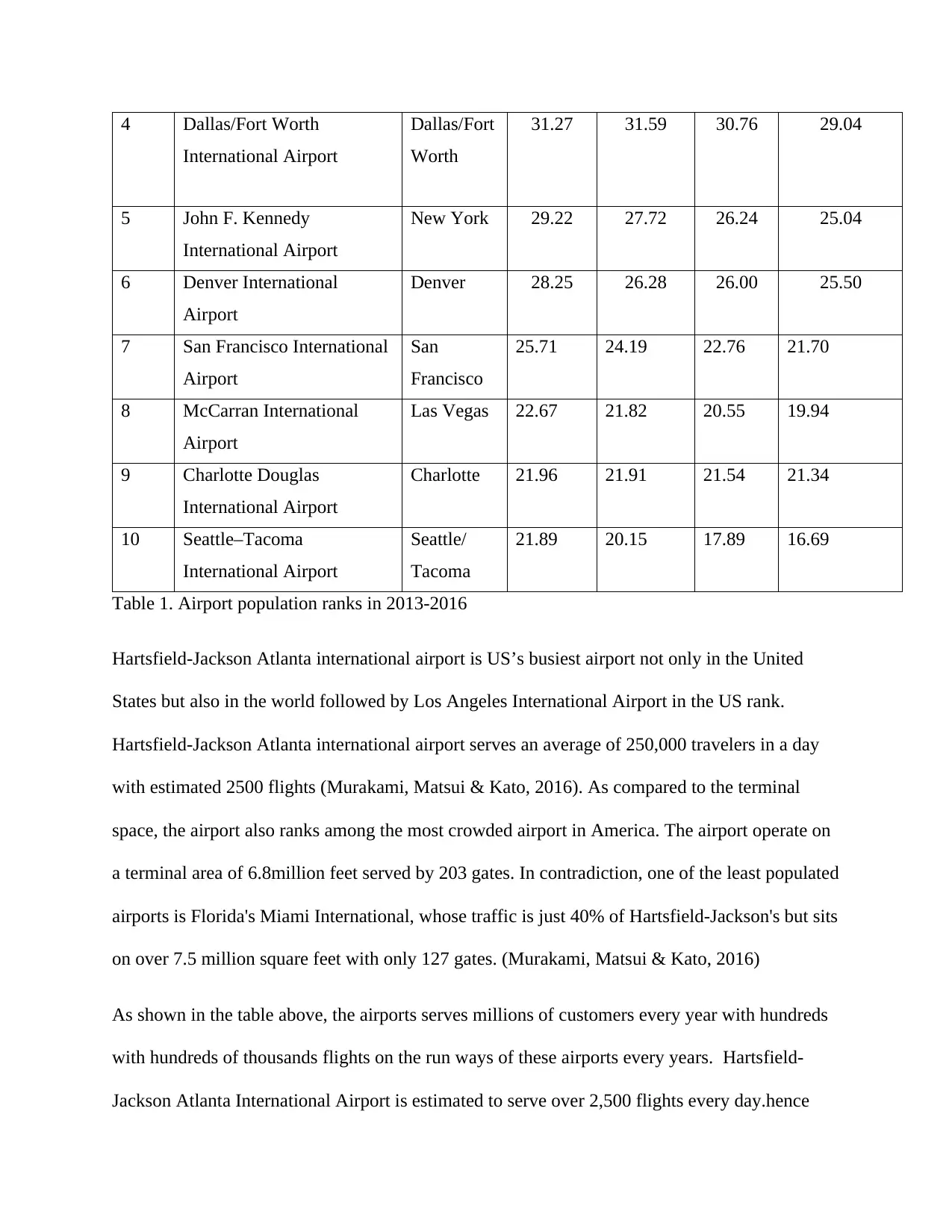
4 Dallas/Fort Worth
International Airport
Dallas/Fort
Worth
31.27 31.59 30.76 29.04
5 John F. Kennedy
International Airport
New York 29.22 27.72 26.24 25.04
6 Denver International
Airport
Denver 28.25 26.28 26.00 25.50
7 San Francisco International
Airport
San
Francisco
25.71 24.19 22.76 21.70
8 McCarran International
Airport
Las Vegas 22.67 21.82 20.55 19.94
9 Charlotte Douglas
International Airport
Charlotte 21.96 21.91 21.54 21.34
10 Seattle–Tacoma
International Airport
Seattle/
Tacoma
21.89 20.15 17.89 16.69
Table 1. Airport population ranks in 2013-2016
Hartsfield-Jackson Atlanta international airport is US’s busiest airport not only in the United
States but also in the world followed by Los Angeles International Airport in the US rank.
Hartsfield-Jackson Atlanta international airport serves an average of 250,000 travelers in a day
with estimated 2500 flights (Murakami, Matsui & Kato, 2016). As compared to the terminal
space, the airport also ranks among the most crowded airport in America. The airport operate on
a terminal area of 6.8million feet served by 203 gates. In contradiction, one of the least populated
airports is Florida's Miami International, whose traffic is just 40% of Hartsfield-Jackson's but sits
on over 7.5 million square feet with only 127 gates. (Murakami, Matsui & Kato, 2016)
As shown in the table above, the airports serves millions of customers every year with hundreds
with hundreds of thousands flights on the run ways of these airports every years. Hartsfield-
Jackson Atlanta International Airport is estimated to serve over 2,500 flights every day.hence
International Airport
Dallas/Fort
Worth
31.27 31.59 30.76 29.04
5 John F. Kennedy
International Airport
New York 29.22 27.72 26.24 25.04
6 Denver International
Airport
Denver 28.25 26.28 26.00 25.50
7 San Francisco International
Airport
San
Francisco
25.71 24.19 22.76 21.70
8 McCarran International
Airport
Las Vegas 22.67 21.82 20.55 19.94
9 Charlotte Douglas
International Airport
Charlotte 21.96 21.91 21.54 21.34
10 Seattle–Tacoma
International Airport
Seattle/
Tacoma
21.89 20.15 17.89 16.69
Table 1. Airport population ranks in 2013-2016
Hartsfield-Jackson Atlanta international airport is US’s busiest airport not only in the United
States but also in the world followed by Los Angeles International Airport in the US rank.
Hartsfield-Jackson Atlanta international airport serves an average of 250,000 travelers in a day
with estimated 2500 flights (Murakami, Matsui & Kato, 2016). As compared to the terminal
space, the airport also ranks among the most crowded airport in America. The airport operate on
a terminal area of 6.8million feet served by 203 gates. In contradiction, one of the least populated
airports is Florida's Miami International, whose traffic is just 40% of Hartsfield-Jackson's but sits
on over 7.5 million square feet with only 127 gates. (Murakami, Matsui & Kato, 2016)
As shown in the table above, the airports serves millions of customers every year with hundreds
with hundreds of thousands flights on the run ways of these airports every years. Hartsfield-
Jackson Atlanta International Airport is estimated to serve over 2,500 flights every day.hence
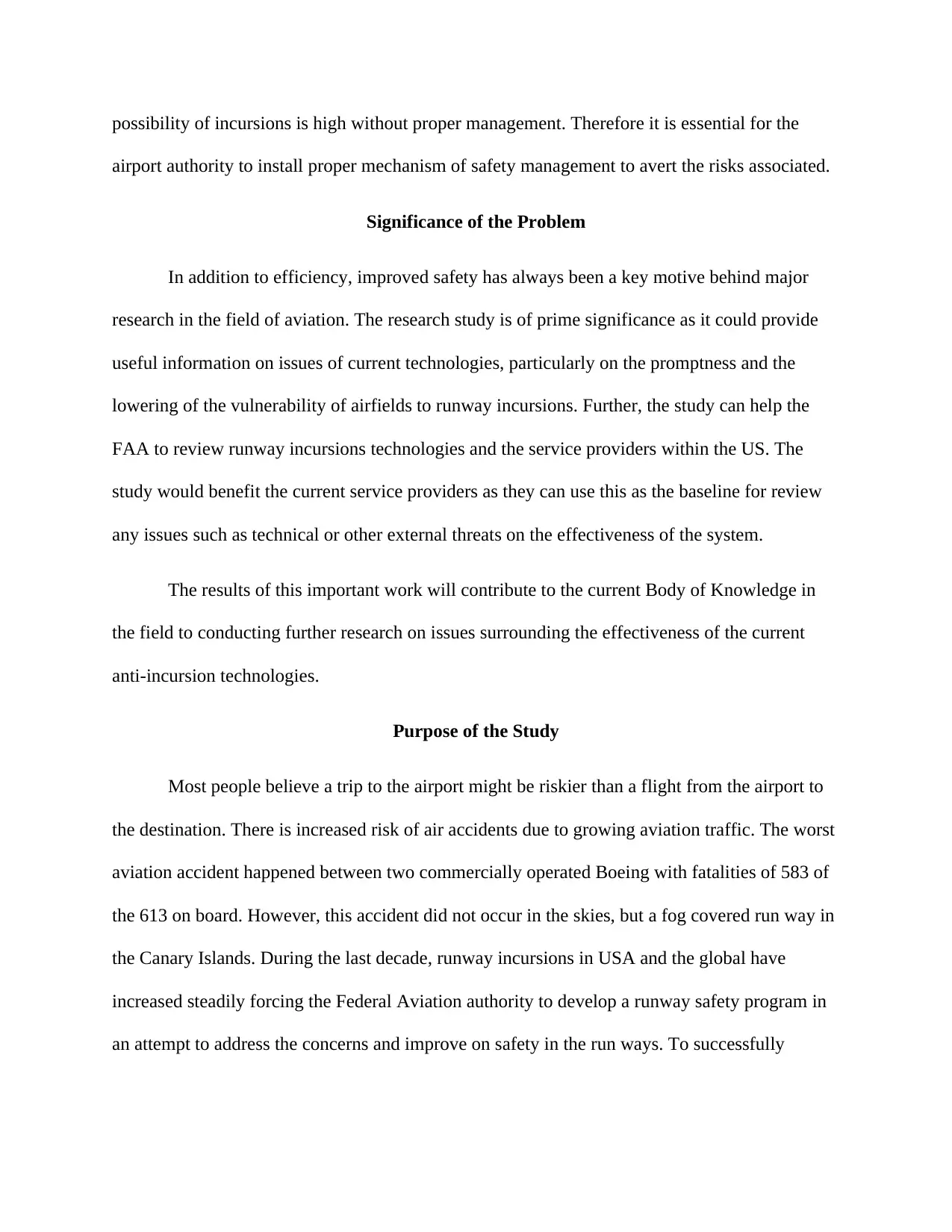
possibility of incursions is high without proper management. Therefore it is essential for the
airport authority to install proper mechanism of safety management to avert the risks associated.
Significance of the Problem
In addition to efficiency, improved safety has always been a key motive behind major
research in the field of aviation. The research study is of prime significance as it could provide
useful information on issues of current technologies, particularly on the promptness and the
lowering of the vulnerability of airfields to runway incursions. Further, the study can help the
FAA to review runway incursions technologies and the service providers within the US. The
study would benefit the current service providers as they can use this as the baseline for review
any issues such as technical or other external threats on the effectiveness of the system.
The results of this important work will contribute to the current Body of Knowledge in
the field to conducting further research on issues surrounding the effectiveness of the current
anti-incursion technologies.
Purpose of the Study
Most people believe a trip to the airport might be riskier than a flight from the airport to
the destination. There is increased risk of air accidents due to growing aviation traffic. The worst
aviation accident happened between two commercially operated Boeing with fatalities of 583 of
the 613 on board. However, this accident did not occur in the skies, but a fog covered run way in
the Canary Islands. During the last decade, runway incursions in USA and the global have
increased steadily forcing the Federal Aviation authority to develop a runway safety program in
an attempt to address the concerns and improve on safety in the run ways. To successfully
airport authority to install proper mechanism of safety management to avert the risks associated.
Significance of the Problem
In addition to efficiency, improved safety has always been a key motive behind major
research in the field of aviation. The research study is of prime significance as it could provide
useful information on issues of current technologies, particularly on the promptness and the
lowering of the vulnerability of airfields to runway incursions. Further, the study can help the
FAA to review runway incursions technologies and the service providers within the US. The
study would benefit the current service providers as they can use this as the baseline for review
any issues such as technical or other external threats on the effectiveness of the system.
The results of this important work will contribute to the current Body of Knowledge in
the field to conducting further research on issues surrounding the effectiveness of the current
anti-incursion technologies.
Purpose of the Study
Most people believe a trip to the airport might be riskier than a flight from the airport to
the destination. There is increased risk of air accidents due to growing aviation traffic. The worst
aviation accident happened between two commercially operated Boeing with fatalities of 583 of
the 613 on board. However, this accident did not occur in the skies, but a fog covered run way in
the Canary Islands. During the last decade, runway incursions in USA and the global have
increased steadily forcing the Federal Aviation authority to develop a runway safety program in
an attempt to address the concerns and improve on safety in the run ways. To successfully

implement safety measure, technology plays a major role. Hence the need to improved and
precise technology to address the challenges.
With the millions of people who use the airport services, there is an imminent threat to
their safety due to the crowded airports and the increased air traffic and activities in the runways.
More than often, safety breaches happen due to the human weakness while controlling the
activities of the port. From research carried out by the FAA on the recent incursion events, it was
identified that the causes could be attributed to operational incidences, pilot deviations,
vehicle/pedestrian deviations. I conducted this Research to contribute to the knowledge of how
this runway incursions can be reduced if not prevented through technology that controls the
parameters which cause the incursions.
According to FAA, for an airport to be operational it requires its Certification since FAA
is charged with the mandate of carrying out certification of the airports after meeting the safety
requirements. The results of this study will give stakeholders of the Runway Safety Area and
FAA an insight on the technology behind runway safety and help in formulation of progressive
safety regulations. It will also give the technology developers some insights in areas to on to
develop compatible technology with the actual needs for the runway safety. It will also play a
great role in educating the stakeholders involved in the right and safe ways to engage in their
business by highlighting the deviations that cause the incursions.
Research Questions and Hypotheses
Research Questions
The national runway safety report for the year 2014-2015 consist of a detailed description of the
current research on effects of technology on runway incursions. The challenges of advancing
runway safety in the future with the introduction of Next Gen technologies and increasing
precise technology to address the challenges.
With the millions of people who use the airport services, there is an imminent threat to
their safety due to the crowded airports and the increased air traffic and activities in the runways.
More than often, safety breaches happen due to the human weakness while controlling the
activities of the port. From research carried out by the FAA on the recent incursion events, it was
identified that the causes could be attributed to operational incidences, pilot deviations,
vehicle/pedestrian deviations. I conducted this Research to contribute to the knowledge of how
this runway incursions can be reduced if not prevented through technology that controls the
parameters which cause the incursions.
According to FAA, for an airport to be operational it requires its Certification since FAA
is charged with the mandate of carrying out certification of the airports after meeting the safety
requirements. The results of this study will give stakeholders of the Runway Safety Area and
FAA an insight on the technology behind runway safety and help in formulation of progressive
safety regulations. It will also give the technology developers some insights in areas to on to
develop compatible technology with the actual needs for the runway safety. It will also play a
great role in educating the stakeholders involved in the right and safe ways to engage in their
business by highlighting the deviations that cause the incursions.
Research Questions and Hypotheses
Research Questions
The national runway safety report for the year 2014-2015 consist of a detailed description of the
current research on effects of technology on runway incursions. The challenges of advancing
runway safety in the future with the introduction of Next Gen technologies and increasing
Paraphrase This Document
Need a fresh take? Get an instant paraphrase of this document with our AI Paraphraser
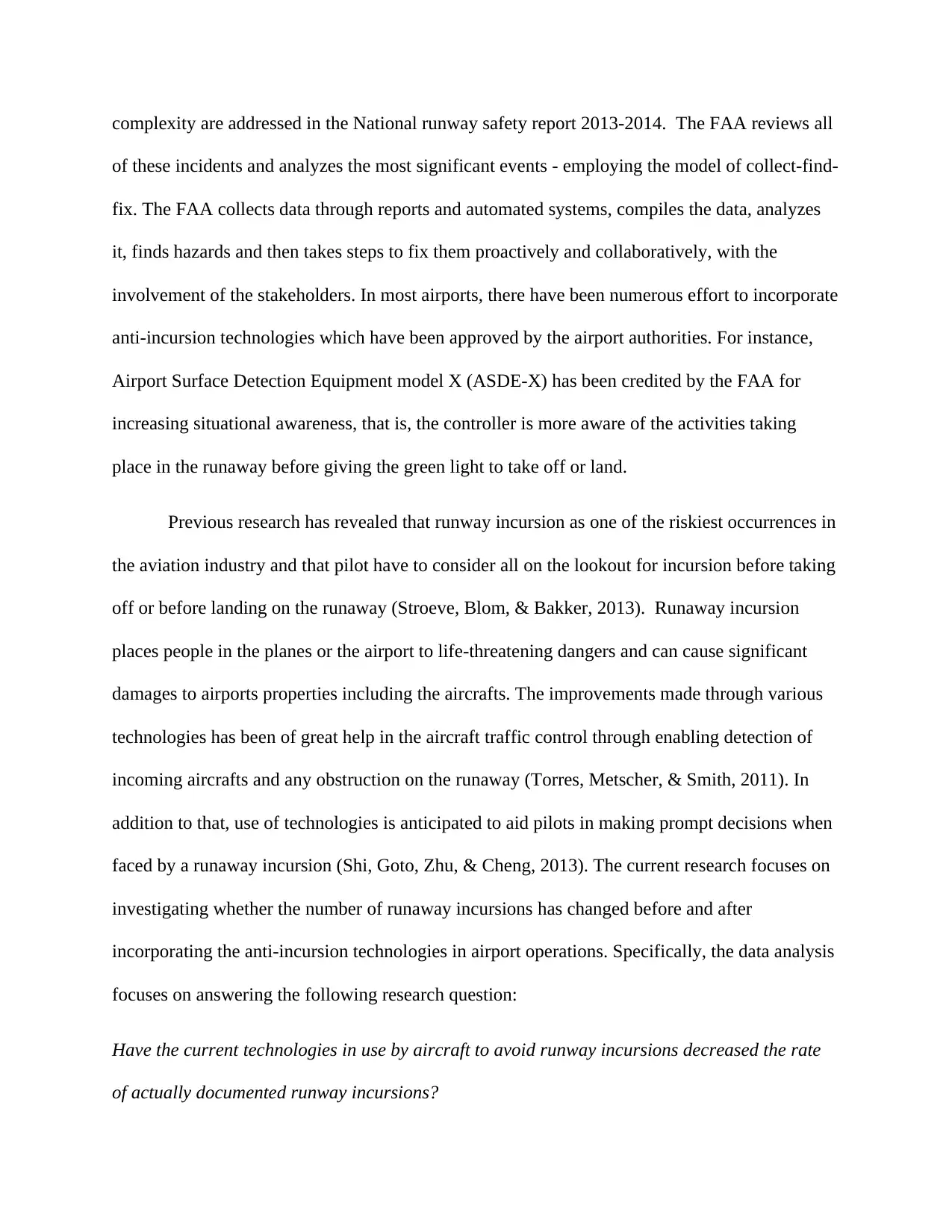
complexity are addressed in the National runway safety report 2013-2014. The FAA reviews all
of these incidents and analyzes the most significant events - employing the model of collect-find-
fix. The FAA collects data through reports and automated systems, compiles the data, analyzes
it, finds hazards and then takes steps to fix them proactively and collaboratively, with the
involvement of the stakeholders. In most airports, there have been numerous effort to incorporate
anti-incursion technologies which have been approved by the airport authorities. For instance,
Airport Surface Detection Equipment model X (ASDE-X) has been credited by the FAA for
increasing situational awareness, that is, the controller is more aware of the activities taking
place in the runaway before giving the green light to take off or land.
Previous research has revealed that runway incursion as one of the riskiest occurrences in
the aviation industry and that pilot have to consider all on the lookout for incursion before taking
off or before landing on the runaway (Stroeve, Blom, & Bakker, 2013). Runaway incursion
places people in the planes or the airport to life-threatening dangers and can cause significant
damages to airports properties including the aircrafts. The improvements made through various
technologies has been of great help in the aircraft traffic control through enabling detection of
incoming aircrafts and any obstruction on the runaway (Torres, Metscher, & Smith, 2011). In
addition to that, use of technologies is anticipated to aid pilots in making prompt decisions when
faced by a runaway incursion (Shi, Goto, Zhu, & Cheng, 2013). The current research focuses on
investigating whether the number of runaway incursions has changed before and after
incorporating the anti-incursion technologies in airport operations. Specifically, the data analysis
focuses on answering the following research question:
Have the current technologies in use by aircraft to avoid runway incursions decreased the rate
of actually documented runway incursions?
of these incidents and analyzes the most significant events - employing the model of collect-find-
fix. The FAA collects data through reports and automated systems, compiles the data, analyzes
it, finds hazards and then takes steps to fix them proactively and collaboratively, with the
involvement of the stakeholders. In most airports, there have been numerous effort to incorporate
anti-incursion technologies which have been approved by the airport authorities. For instance,
Airport Surface Detection Equipment model X (ASDE-X) has been credited by the FAA for
increasing situational awareness, that is, the controller is more aware of the activities taking
place in the runaway before giving the green light to take off or land.
Previous research has revealed that runway incursion as one of the riskiest occurrences in
the aviation industry and that pilot have to consider all on the lookout for incursion before taking
off or before landing on the runaway (Stroeve, Blom, & Bakker, 2013). Runaway incursion
places people in the planes or the airport to life-threatening dangers and can cause significant
damages to airports properties including the aircrafts. The improvements made through various
technologies has been of great help in the aircraft traffic control through enabling detection of
incoming aircrafts and any obstruction on the runaway (Torres, Metscher, & Smith, 2011). In
addition to that, use of technologies is anticipated to aid pilots in making prompt decisions when
faced by a runaway incursion (Shi, Goto, Zhu, & Cheng, 2013). The current research focuses on
investigating whether the number of runaway incursions has changed before and after
incorporating the anti-incursion technologies in airport operations. Specifically, the data analysis
focuses on answering the following research question:
Have the current technologies in use by aircraft to avoid runway incursions decreased the rate
of actually documented runway incursions?
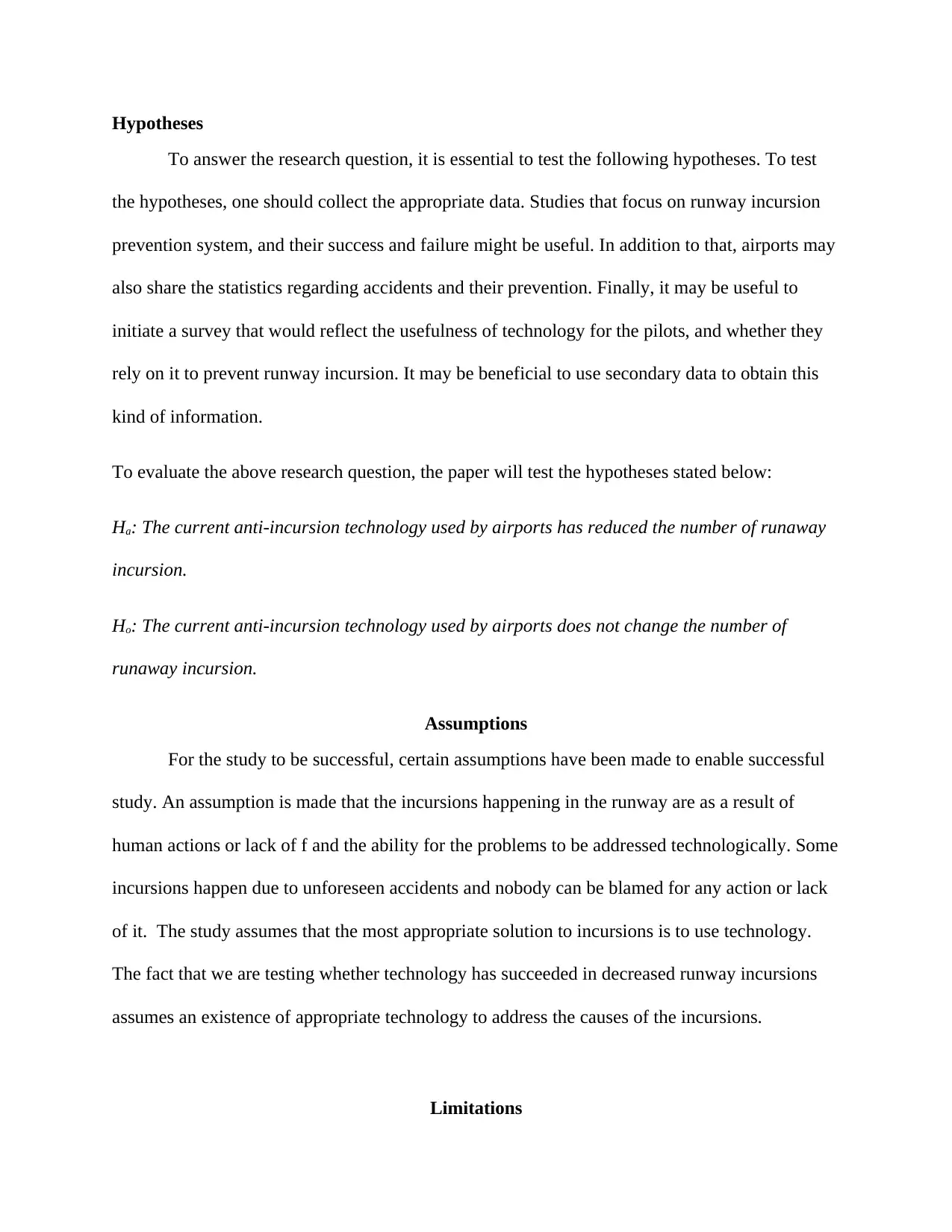
Hypotheses
To answer the research question, it is essential to test the following hypotheses. To test
the hypotheses, one should collect the appropriate data. Studies that focus on runway incursion
prevention system, and their success and failure might be useful. In addition to that, airports may
also share the statistics regarding accidents and their prevention. Finally, it may be useful to
initiate a survey that would reflect the usefulness of technology for the pilots, and whether they
rely on it to prevent runway incursion. It may be beneficial to use secondary data to obtain this
kind of information.
To evaluate the above research question, the paper will test the hypotheses stated below:
Ha: The current anti-incursion technology used by airports has reduced the number of runaway
incursion.
Ho: The current anti-incursion technology used by airports does not change the number of
runaway incursion.
Assumptions
For the study to be successful, certain assumptions have been made to enable successful
study. An assumption is made that the incursions happening in the runway are as a result of
human actions or lack of f and the ability for the problems to be addressed technologically. Some
incursions happen due to unforeseen accidents and nobody can be blamed for any action or lack
of it. The study assumes that the most appropriate solution to incursions is to use technology.
The fact that we are testing whether technology has succeeded in decreased runway incursions
assumes an existence of appropriate technology to address the causes of the incursions.
Limitations
To answer the research question, it is essential to test the following hypotheses. To test
the hypotheses, one should collect the appropriate data. Studies that focus on runway incursion
prevention system, and their success and failure might be useful. In addition to that, airports may
also share the statistics regarding accidents and their prevention. Finally, it may be useful to
initiate a survey that would reflect the usefulness of technology for the pilots, and whether they
rely on it to prevent runway incursion. It may be beneficial to use secondary data to obtain this
kind of information.
To evaluate the above research question, the paper will test the hypotheses stated below:
Ha: The current anti-incursion technology used by airports has reduced the number of runaway
incursion.
Ho: The current anti-incursion technology used by airports does not change the number of
runaway incursion.
Assumptions
For the study to be successful, certain assumptions have been made to enable successful
study. An assumption is made that the incursions happening in the runway are as a result of
human actions or lack of f and the ability for the problems to be addressed technologically. Some
incursions happen due to unforeseen accidents and nobody can be blamed for any action or lack
of it. The study assumes that the most appropriate solution to incursions is to use technology.
The fact that we are testing whether technology has succeeded in decreased runway incursions
assumes an existence of appropriate technology to address the causes of the incursions.
Limitations
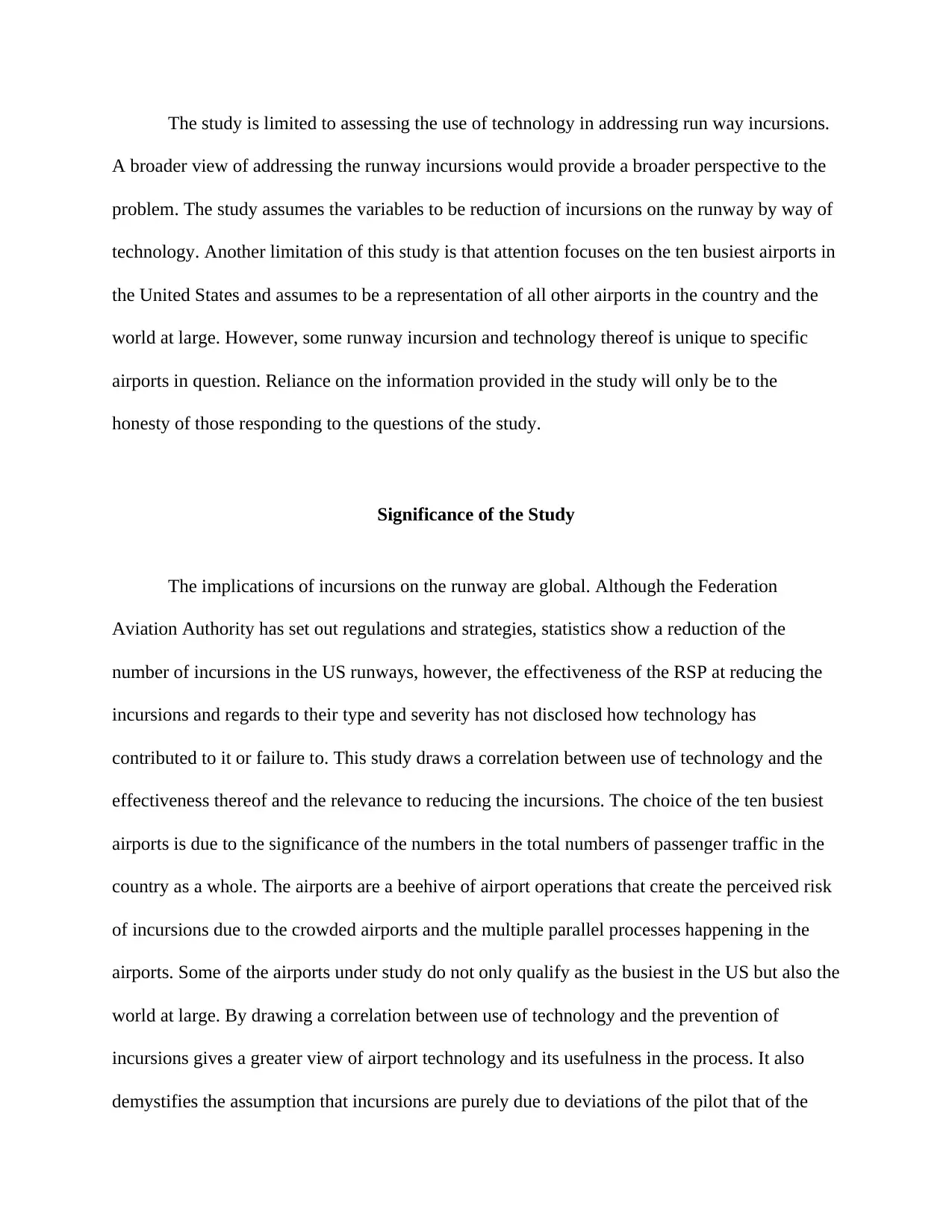
The study is limited to assessing the use of technology in addressing run way incursions.
A broader view of addressing the runway incursions would provide a broader perspective to the
problem. The study assumes the variables to be reduction of incursions on the runway by way of
technology. Another limitation of this study is that attention focuses on the ten busiest airports in
the United States and assumes to be a representation of all other airports in the country and the
world at large. However, some runway incursion and technology thereof is unique to specific
airports in question. Reliance on the information provided in the study will only be to the
honesty of those responding to the questions of the study.
Significance of the Study
The implications of incursions on the runway are global. Although the Federation
Aviation Authority has set out regulations and strategies, statistics show a reduction of the
number of incursions in the US runways, however, the effectiveness of the RSP at reducing the
incursions and regards to their type and severity has not disclosed how technology has
contributed to it or failure to. This study draws a correlation between use of technology and the
effectiveness thereof and the relevance to reducing the incursions. The choice of the ten busiest
airports is due to the significance of the numbers in the total numbers of passenger traffic in the
country as a whole. The airports are a beehive of airport operations that create the perceived risk
of incursions due to the crowded airports and the multiple parallel processes happening in the
airports. Some of the airports under study do not only qualify as the busiest in the US but also the
world at large. By drawing a correlation between use of technology and the prevention of
incursions gives a greater view of airport technology and its usefulness in the process. It also
demystifies the assumption that incursions are purely due to deviations of the pilot that of the
A broader view of addressing the runway incursions would provide a broader perspective to the
problem. The study assumes the variables to be reduction of incursions on the runway by way of
technology. Another limitation of this study is that attention focuses on the ten busiest airports in
the United States and assumes to be a representation of all other airports in the country and the
world at large. However, some runway incursion and technology thereof is unique to specific
airports in question. Reliance on the information provided in the study will only be to the
honesty of those responding to the questions of the study.
Significance of the Study
The implications of incursions on the runway are global. Although the Federation
Aviation Authority has set out regulations and strategies, statistics show a reduction of the
number of incursions in the US runways, however, the effectiveness of the RSP at reducing the
incursions and regards to their type and severity has not disclosed how technology has
contributed to it or failure to. This study draws a correlation between use of technology and the
effectiveness thereof and the relevance to reducing the incursions. The choice of the ten busiest
airports is due to the significance of the numbers in the total numbers of passenger traffic in the
country as a whole. The airports are a beehive of airport operations that create the perceived risk
of incursions due to the crowded airports and the multiple parallel processes happening in the
airports. Some of the airports under study do not only qualify as the busiest in the US but also the
world at large. By drawing a correlation between use of technology and the prevention of
incursions gives a greater view of airport technology and its usefulness in the process. It also
demystifies the assumption that incursions are purely due to deviations of the pilot that of the
Secure Best Marks with AI Grader
Need help grading? Try our AI Grader for instant feedback on your assignments.
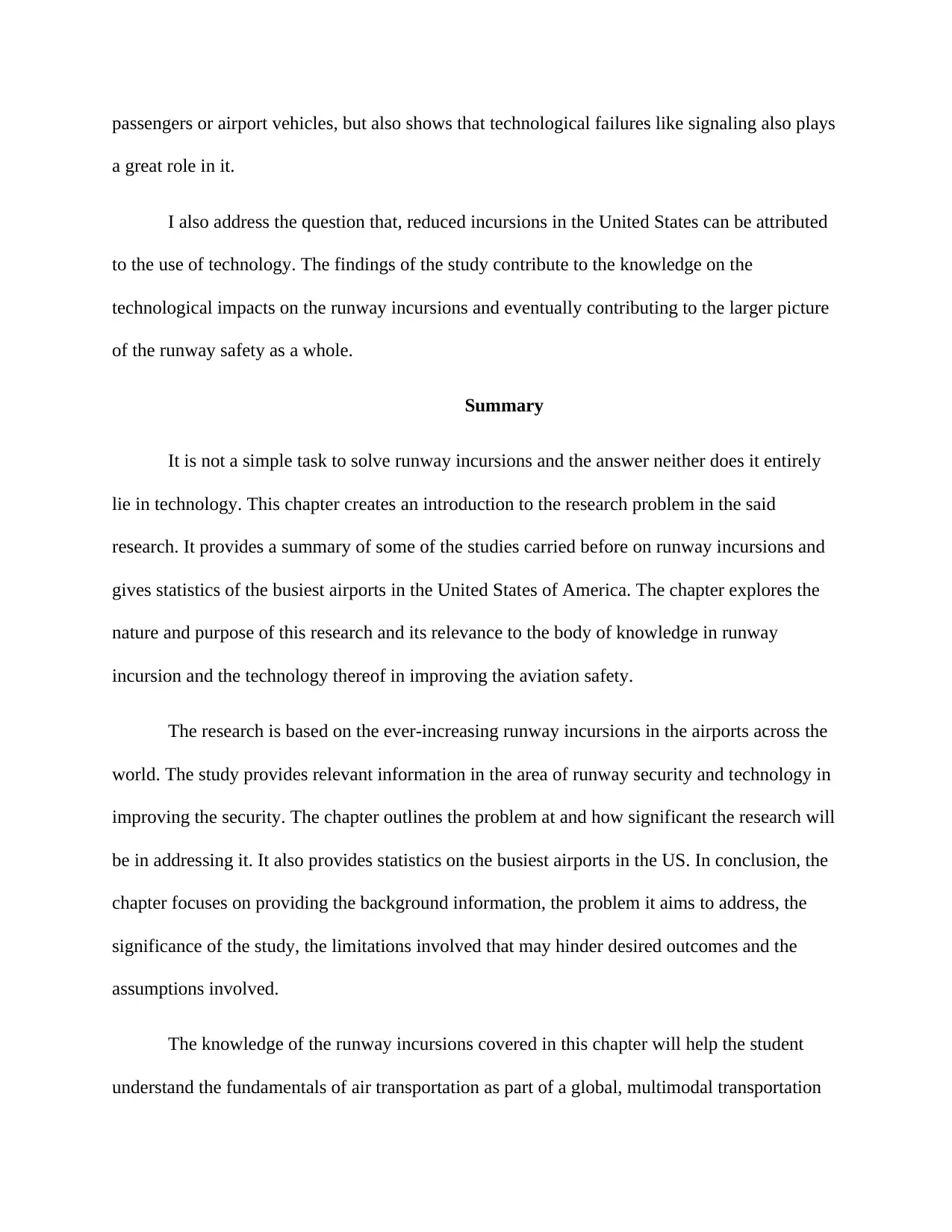
passengers or airport vehicles, but also shows that technological failures like signaling also plays
a great role in it.
I also address the question that, reduced incursions in the United States can be attributed
to the use of technology. The findings of the study contribute to the knowledge on the
technological impacts on the runway incursions and eventually contributing to the larger picture
of the runway safety as a whole.
Summary
It is not a simple task to solve runway incursions and the answer neither does it entirely
lie in technology. This chapter creates an introduction to the research problem in the said
research. It provides a summary of some of the studies carried before on runway incursions and
gives statistics of the busiest airports in the United States of America. The chapter explores the
nature and purpose of this research and its relevance to the body of knowledge in runway
incursion and the technology thereof in improving the aviation safety.
The research is based on the ever-increasing runway incursions in the airports across the
world. The study provides relevant information in the area of runway security and technology in
improving the security. The chapter outlines the problem at and how significant the research will
be in addressing it. It also provides statistics on the busiest airports in the US. In conclusion, the
chapter focuses on providing the background information, the problem it aims to address, the
significance of the study, the limitations involved that may hinder desired outcomes and the
assumptions involved.
The knowledge of the runway incursions covered in this chapter will help the student
understand the fundamentals of air transportation as part of a global, multimodal transportation
a great role in it.
I also address the question that, reduced incursions in the United States can be attributed
to the use of technology. The findings of the study contribute to the knowledge on the
technological impacts on the runway incursions and eventually contributing to the larger picture
of the runway safety as a whole.
Summary
It is not a simple task to solve runway incursions and the answer neither does it entirely
lie in technology. This chapter creates an introduction to the research problem in the said
research. It provides a summary of some of the studies carried before on runway incursions and
gives statistics of the busiest airports in the United States of America. The chapter explores the
nature and purpose of this research and its relevance to the body of knowledge in runway
incursion and the technology thereof in improving the aviation safety.
The research is based on the ever-increasing runway incursions in the airports across the
world. The study provides relevant information in the area of runway security and technology in
improving the security. The chapter outlines the problem at and how significant the research will
be in addressing it. It also provides statistics on the busiest airports in the US. In conclusion, the
chapter focuses on providing the background information, the problem it aims to address, the
significance of the study, the limitations involved that may hinder desired outcomes and the
assumptions involved.
The knowledge of the runway incursions covered in this chapter will help the student
understand the fundamentals of air transportation as part of a global, multimodal transportation
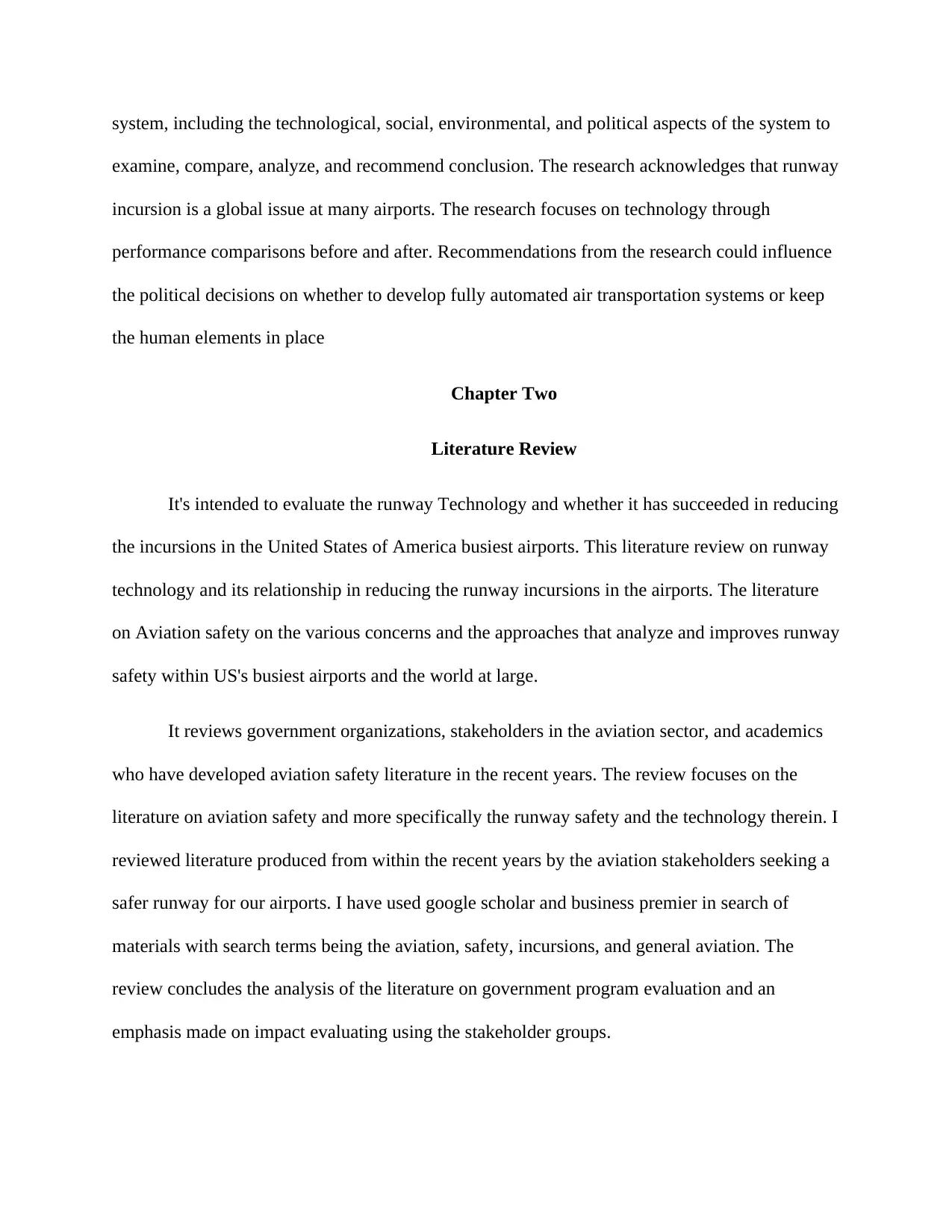
system, including the technological, social, environmental, and political aspects of the system to
examine, compare, analyze, and recommend conclusion. The research acknowledges that runway
incursion is a global issue at many airports. The research focuses on technology through
performance comparisons before and after. Recommendations from the research could influence
the political decisions on whether to develop fully automated air transportation systems or keep
the human elements in place
Chapter Two
Literature Review
It's intended to evaluate the runway Technology and whether it has succeeded in reducing
the incursions in the United States of America busiest airports. This literature review on runway
technology and its relationship in reducing the runway incursions in the airports. The literature
on Aviation safety on the various concerns and the approaches that analyze and improves runway
safety within US's busiest airports and the world at large.
It reviews government organizations, stakeholders in the aviation sector, and academics
who have developed aviation safety literature in the recent years. The review focuses on the
literature on aviation safety and more specifically the runway safety and the technology therein. I
reviewed literature produced from within the recent years by the aviation stakeholders seeking a
safer runway for our airports. I have used google scholar and business premier in search of
materials with search terms being the aviation, safety, incursions, and general aviation. The
review concludes the analysis of the literature on government program evaluation and an
emphasis made on impact evaluating using the stakeholder groups.
examine, compare, analyze, and recommend conclusion. The research acknowledges that runway
incursion is a global issue at many airports. The research focuses on technology through
performance comparisons before and after. Recommendations from the research could influence
the political decisions on whether to develop fully automated air transportation systems or keep
the human elements in place
Chapter Two
Literature Review
It's intended to evaluate the runway Technology and whether it has succeeded in reducing
the incursions in the United States of America busiest airports. This literature review on runway
technology and its relationship in reducing the runway incursions in the airports. The literature
on Aviation safety on the various concerns and the approaches that analyze and improves runway
safety within US's busiest airports and the world at large.
It reviews government organizations, stakeholders in the aviation sector, and academics
who have developed aviation safety literature in the recent years. The review focuses on the
literature on aviation safety and more specifically the runway safety and the technology therein. I
reviewed literature produced from within the recent years by the aviation stakeholders seeking a
safer runway for our airports. I have used google scholar and business premier in search of
materials with search terms being the aviation, safety, incursions, and general aviation. The
review concludes the analysis of the literature on government program evaluation and an
emphasis made on impact evaluating using the stakeholder groups.

Governmental Aviation Safety Literature
The literature in government is created by the agencies mandated to address the
significance of runway incursions and security therein. In the United States, the Federal Aviation
Authority consistently creates the reports as well as other interested government agencies such as
National Science Board, Government Accountability Office, and Office of the Inspector General
among others like Transport Department. The government agencies have recognized the threat of
runway incursions and provide recommendations to FAA to avert the situations. One of the
reports done by FAA was 2009-2011 National Runway Safety plan which addressed the
recommendations from the NTSB, the U.S. GAO, and the transport department (FAA, 2008).
Each of the government agencies conducted their independent studies and provided the FAA
with recommendations to on how to reduce the frequency, the various types, and severity of the
incursions. The recommendations made a key component of the FAA 2009-2011 RSP (FAA,
2008)
National Transportation Safety Board
The national transportation board is an independent board charged with the mandate to
investigate and determine probable causes of a civil aviation accident in the United States. Its
primary mandate is to conduct objective, precise accident investigations, conduct fair and
objective certification appeals and to advocate and promote safety recommendations.it originated
in the air commerce ACT of 1926 in which the United States Government through the
department of commerce investigating the causes of aircraft accidents a responsibility which was
later given to Civil Aeronautics Board bureau of Aviation Safety when created in 1940. The
body issued a letter of recommendations addressed to FAA (NTSB, 2000) the report
recommended that FAA took actions in reducing the incursions through the following steps. (1)
The literature in government is created by the agencies mandated to address the
significance of runway incursions and security therein. In the United States, the Federal Aviation
Authority consistently creates the reports as well as other interested government agencies such as
National Science Board, Government Accountability Office, and Office of the Inspector General
among others like Transport Department. The government agencies have recognized the threat of
runway incursions and provide recommendations to FAA to avert the situations. One of the
reports done by FAA was 2009-2011 National Runway Safety plan which addressed the
recommendations from the NTSB, the U.S. GAO, and the transport department (FAA, 2008).
Each of the government agencies conducted their independent studies and provided the FAA
with recommendations to on how to reduce the frequency, the various types, and severity of the
incursions. The recommendations made a key component of the FAA 2009-2011 RSP (FAA,
2008)
National Transportation Safety Board
The national transportation board is an independent board charged with the mandate to
investigate and determine probable causes of a civil aviation accident in the United States. Its
primary mandate is to conduct objective, precise accident investigations, conduct fair and
objective certification appeals and to advocate and promote safety recommendations.it originated
in the air commerce ACT of 1926 in which the United States Government through the
department of commerce investigating the causes of aircraft accidents a responsibility which was
later given to Civil Aeronautics Board bureau of Aviation Safety when created in 1940. The
body issued a letter of recommendations addressed to FAA (NTSB, 2000) the report
recommended that FAA took actions in reducing the incursions through the following steps. (1)
Paraphrase This Document
Need a fresh take? Get an instant paraphrase of this document with our AI Paraphraser

All airports to install scheduled passenger service and to establish a ground movement safety
systems that give direct warnings to the crew about possible runway incursions. (2) Amend FAA
order 7110.65 involving traffic control procedures that require aircrafts crossing multiple
runways be issued ATC crossing instructions for each runway be issued after crossing the
previous runway (NTSB,2000,p. 16). (3) To mandate that all code of Federal Regulations parts
121, 135 and 91 to conduct arrival landings distance assessments before every landing based on
existing performance data. The body is an important stakeholder in the aviation sector safety
and runway incursions prevention I the airports. Its inputs in the FAA strategies plays a big role
and impact on the strategies adopted.
International Governmental Runway Incursion Literature
International government organizations have also weighed in in the provision of the
literature to complement the federal government agencies to reduce incursion in the runways.
They represent many countries that have struggled to reduce runway incursions. Their efforts
have led to the development of literature regarding the global trend and challenges seeking the
reduction of the incursions and to increase the safety within the aviation facilities. The
Australian Transport Safety Bureau (2004) concluded that a majority of the incursions were
caused by problems in communication between the aircraft controller and third parties most
often the pilot.
The international air Transport Association (2006) examined the components that are
associated with accident classifications system and underlying risks caused by human technical,
environmental and organizational components. Even though most researchers have concentrated
in reduced aviation accidents, some have narrowed down to technological advancements about
Run way incursions (Horowitz & Santos, 2009; Schonefeld & Moller, 2012).
systems that give direct warnings to the crew about possible runway incursions. (2) Amend FAA
order 7110.65 involving traffic control procedures that require aircrafts crossing multiple
runways be issued ATC crossing instructions for each runway be issued after crossing the
previous runway (NTSB,2000,p. 16). (3) To mandate that all code of Federal Regulations parts
121, 135 and 91 to conduct arrival landings distance assessments before every landing based on
existing performance data. The body is an important stakeholder in the aviation sector safety
and runway incursions prevention I the airports. Its inputs in the FAA strategies plays a big role
and impact on the strategies adopted.
International Governmental Runway Incursion Literature
International government organizations have also weighed in in the provision of the
literature to complement the federal government agencies to reduce incursion in the runways.
They represent many countries that have struggled to reduce runway incursions. Their efforts
have led to the development of literature regarding the global trend and challenges seeking the
reduction of the incursions and to increase the safety within the aviation facilities. The
Australian Transport Safety Bureau (2004) concluded that a majority of the incursions were
caused by problems in communication between the aircraft controller and third parties most
often the pilot.
The international air Transport Association (2006) examined the components that are
associated with accident classifications system and underlying risks caused by human technical,
environmental and organizational components. Even though most researchers have concentrated
in reduced aviation accidents, some have narrowed down to technological advancements about
Run way incursions (Horowitz & Santos, 2009; Schonefeld & Moller, 2012).
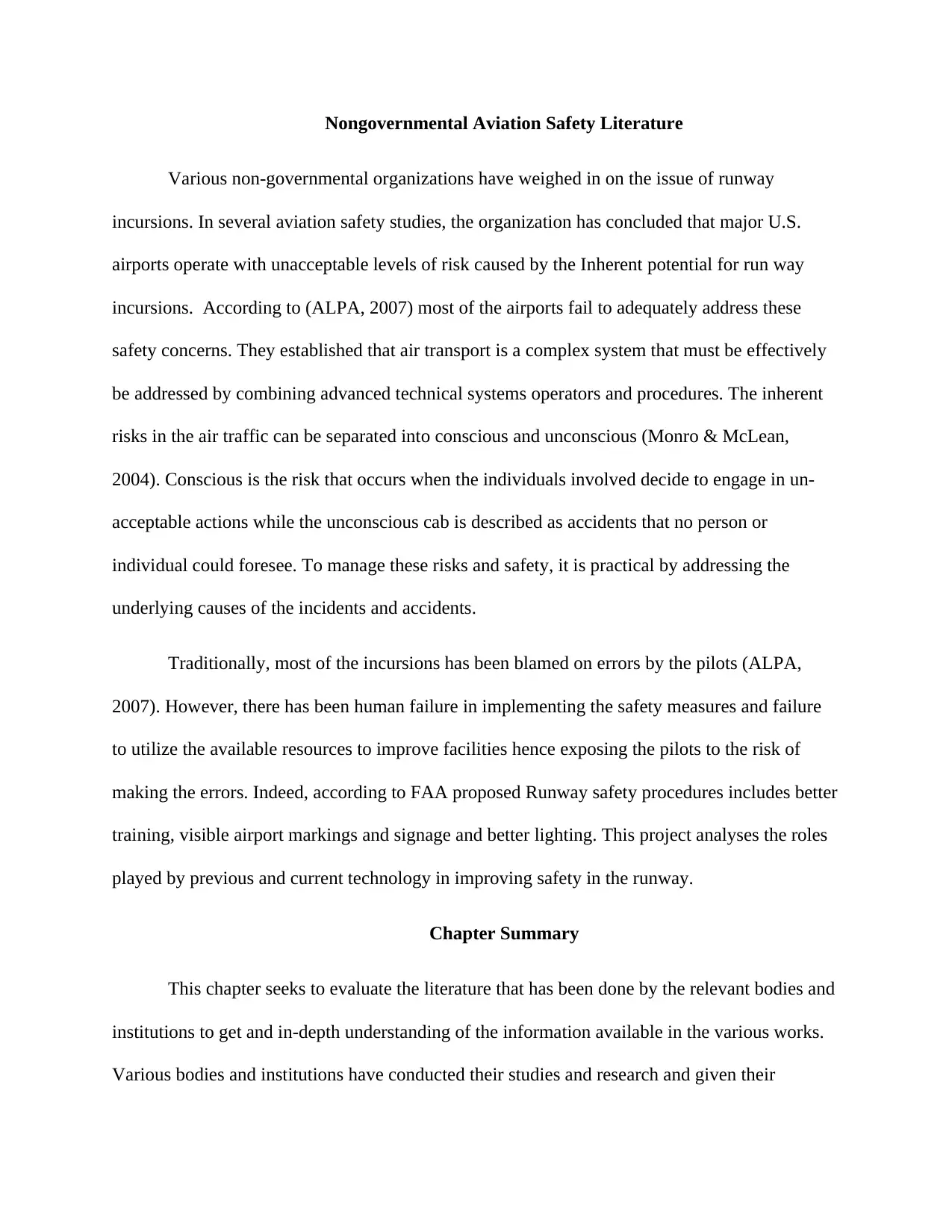
Nongovernmental Aviation Safety Literature
Various non-governmental organizations have weighed in on the issue of runway
incursions. In several aviation safety studies, the organization has concluded that major U.S.
airports operate with unacceptable levels of risk caused by the Inherent potential for run way
incursions. According to (ALPA, 2007) most of the airports fail to adequately address these
safety concerns. They established that air transport is a complex system that must be effectively
be addressed by combining advanced technical systems operators and procedures. The inherent
risks in the air traffic can be separated into conscious and unconscious (Monro & McLean,
2004). Conscious is the risk that occurs when the individuals involved decide to engage in un-
acceptable actions while the unconscious cab is described as accidents that no person or
individual could foresee. To manage these risks and safety, it is practical by addressing the
underlying causes of the incidents and accidents.
Traditionally, most of the incursions has been blamed on errors by the pilots (ALPA,
2007). However, there has been human failure in implementing the safety measures and failure
to utilize the available resources to improve facilities hence exposing the pilots to the risk of
making the errors. Indeed, according to FAA proposed Runway safety procedures includes better
training, visible airport markings and signage and better lighting. This project analyses the roles
played by previous and current technology in improving safety in the runway.
Chapter Summary
This chapter seeks to evaluate the literature that has been done by the relevant bodies and
institutions to get and in-depth understanding of the information available in the various works.
Various bodies and institutions have conducted their studies and research and given their
Various non-governmental organizations have weighed in on the issue of runway
incursions. In several aviation safety studies, the organization has concluded that major U.S.
airports operate with unacceptable levels of risk caused by the Inherent potential for run way
incursions. According to (ALPA, 2007) most of the airports fail to adequately address these
safety concerns. They established that air transport is a complex system that must be effectively
be addressed by combining advanced technical systems operators and procedures. The inherent
risks in the air traffic can be separated into conscious and unconscious (Monro & McLean,
2004). Conscious is the risk that occurs when the individuals involved decide to engage in un-
acceptable actions while the unconscious cab is described as accidents that no person or
individual could foresee. To manage these risks and safety, it is practical by addressing the
underlying causes of the incidents and accidents.
Traditionally, most of the incursions has been blamed on errors by the pilots (ALPA,
2007). However, there has been human failure in implementing the safety measures and failure
to utilize the available resources to improve facilities hence exposing the pilots to the risk of
making the errors. Indeed, according to FAA proposed Runway safety procedures includes better
training, visible airport markings and signage and better lighting. This project analyses the roles
played by previous and current technology in improving safety in the runway.
Chapter Summary
This chapter seeks to evaluate the literature that has been done by the relevant bodies and
institutions to get and in-depth understanding of the information available in the various works.
Various bodies and institutions have conducted their studies and research and given their

recommendations and insights to the relevant parties.Government institutions both in the Federal
Government and the international arena have provided useful literature on the runway incursions.
Globally, different researchers have universally recognized the threat of incursions as global and
the need to be addressed technologically. However, in the aviation safety literature, the
researchers consistently described the threats associated with runway incursions but have not
described the best way to prevent or reduce the potential risks associated with incursions in the
runway.
The student will the able to analyze the human factors that contribute to the incursions on
the runway including the unsafe acts, attitudes, errors, human behaviors and limitations and how
technology contributes in addressing them in order to reach to conclusions. This research is
based on human-machine interactions with equal emphasis to either elements. Human-Factors is
at the heart of aviation and remains a constant topic throughout this research. The conclusions
reach here could differ from other studies since there are certain levels of unpredictability in the
human mindset.
Government and the international arena have provided useful literature on the runway incursions.
Globally, different researchers have universally recognized the threat of incursions as global and
the need to be addressed technologically. However, in the aviation safety literature, the
researchers consistently described the threats associated with runway incursions but have not
described the best way to prevent or reduce the potential risks associated with incursions in the
runway.
The student will the able to analyze the human factors that contribute to the incursions on
the runway including the unsafe acts, attitudes, errors, human behaviors and limitations and how
technology contributes in addressing them in order to reach to conclusions. This research is
based on human-machine interactions with equal emphasis to either elements. Human-Factors is
at the heart of aviation and remains a constant topic throughout this research. The conclusions
reach here could differ from other studies since there are certain levels of unpredictability in the
human mindset.
Secure Best Marks with AI Grader
Need help grading? Try our AI Grader for instant feedback on your assignments.
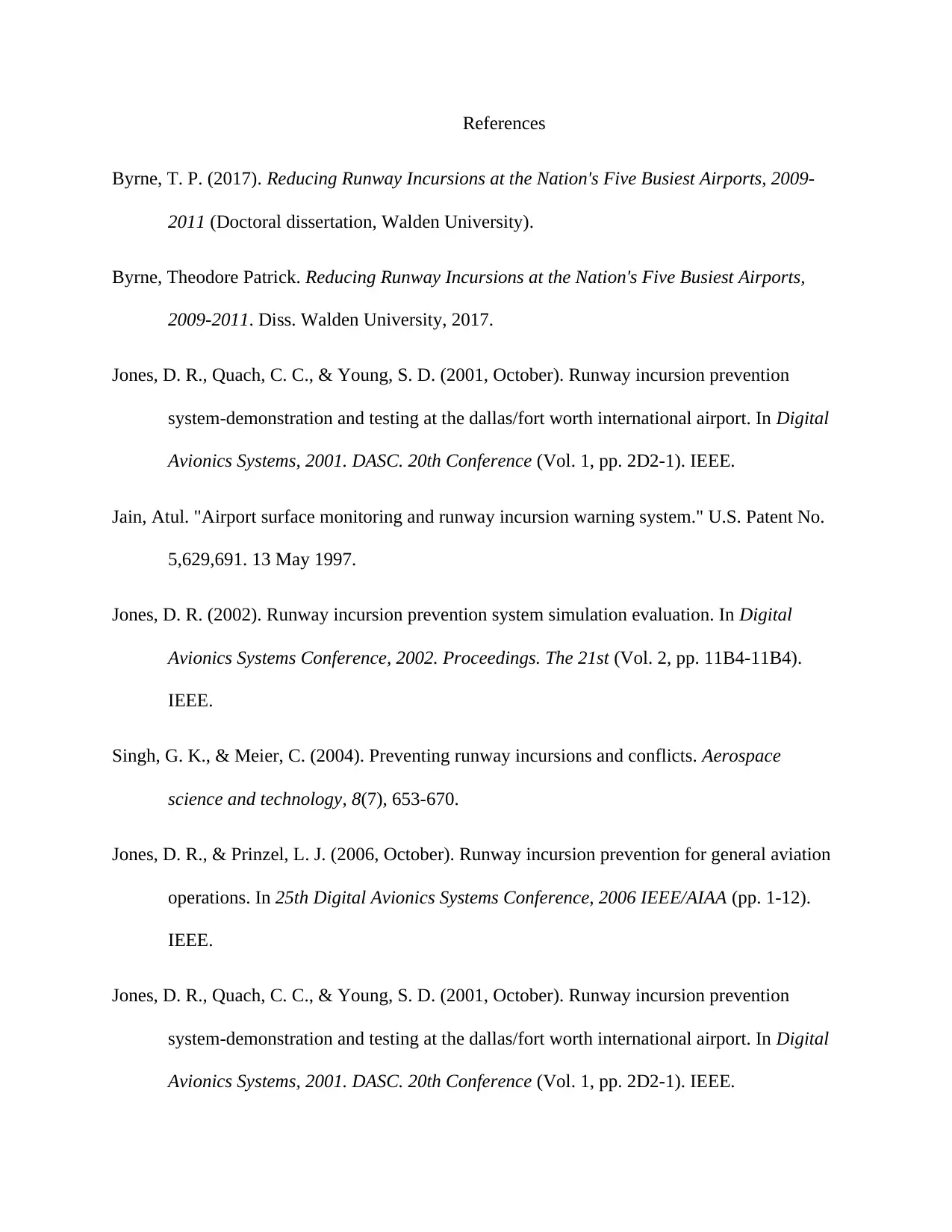
References
Byrne, T. P. (2017). Reducing Runway Incursions at the Nation's Five Busiest Airports, 2009-
2011 (Doctoral dissertation, Walden University).
Byrne, Theodore Patrick. Reducing Runway Incursions at the Nation's Five Busiest Airports,
2009-2011. Diss. Walden University, 2017.
Jones, D. R., Quach, C. C., & Young, S. D. (2001, October). Runway incursion prevention
system-demonstration and testing at the dallas/fort worth international airport. In Digital
Avionics Systems, 2001. DASC. 20th Conference (Vol. 1, pp. 2D2-1). IEEE.
Jain, Atul. "Airport surface monitoring and runway incursion warning system." U.S. Patent No.
5,629,691. 13 May 1997.
Jones, D. R. (2002). Runway incursion prevention system simulation evaluation. In Digital
Avionics Systems Conference, 2002. Proceedings. The 21st (Vol. 2, pp. 11B4-11B4).
IEEE.
Singh, G. K., & Meier, C. (2004). Preventing runway incursions and conflicts. Aerospace
science and technology, 8(7), 653-670.
Jones, D. R., & Prinzel, L. J. (2006, October). Runway incursion prevention for general aviation
operations. In 25th Digital Avionics Systems Conference, 2006 IEEE/AIAA (pp. 1-12).
IEEE.
Jones, D. R., Quach, C. C., & Young, S. D. (2001, October). Runway incursion prevention
system-demonstration and testing at the dallas/fort worth international airport. In Digital
Avionics Systems, 2001. DASC. 20th Conference (Vol. 1, pp. 2D2-1). IEEE.
Byrne, T. P. (2017). Reducing Runway Incursions at the Nation's Five Busiest Airports, 2009-
2011 (Doctoral dissertation, Walden University).
Byrne, Theodore Patrick. Reducing Runway Incursions at the Nation's Five Busiest Airports,
2009-2011. Diss. Walden University, 2017.
Jones, D. R., Quach, C. C., & Young, S. D. (2001, October). Runway incursion prevention
system-demonstration and testing at the dallas/fort worth international airport. In Digital
Avionics Systems, 2001. DASC. 20th Conference (Vol. 1, pp. 2D2-1). IEEE.
Jain, Atul. "Airport surface monitoring and runway incursion warning system." U.S. Patent No.
5,629,691. 13 May 1997.
Jones, D. R. (2002). Runway incursion prevention system simulation evaluation. In Digital
Avionics Systems Conference, 2002. Proceedings. The 21st (Vol. 2, pp. 11B4-11B4).
IEEE.
Singh, G. K., & Meier, C. (2004). Preventing runway incursions and conflicts. Aerospace
science and technology, 8(7), 653-670.
Jones, D. R., & Prinzel, L. J. (2006, October). Runway incursion prevention for general aviation
operations. In 25th Digital Avionics Systems Conference, 2006 IEEE/AIAA (pp. 1-12).
IEEE.
Jones, D. R., Quach, C. C., & Young, S. D. (2001, October). Runway incursion prevention
system-demonstration and testing at the dallas/fort worth international airport. In Digital
Avionics Systems, 2001. DASC. 20th Conference (Vol. 1, pp. 2D2-1). IEEE.
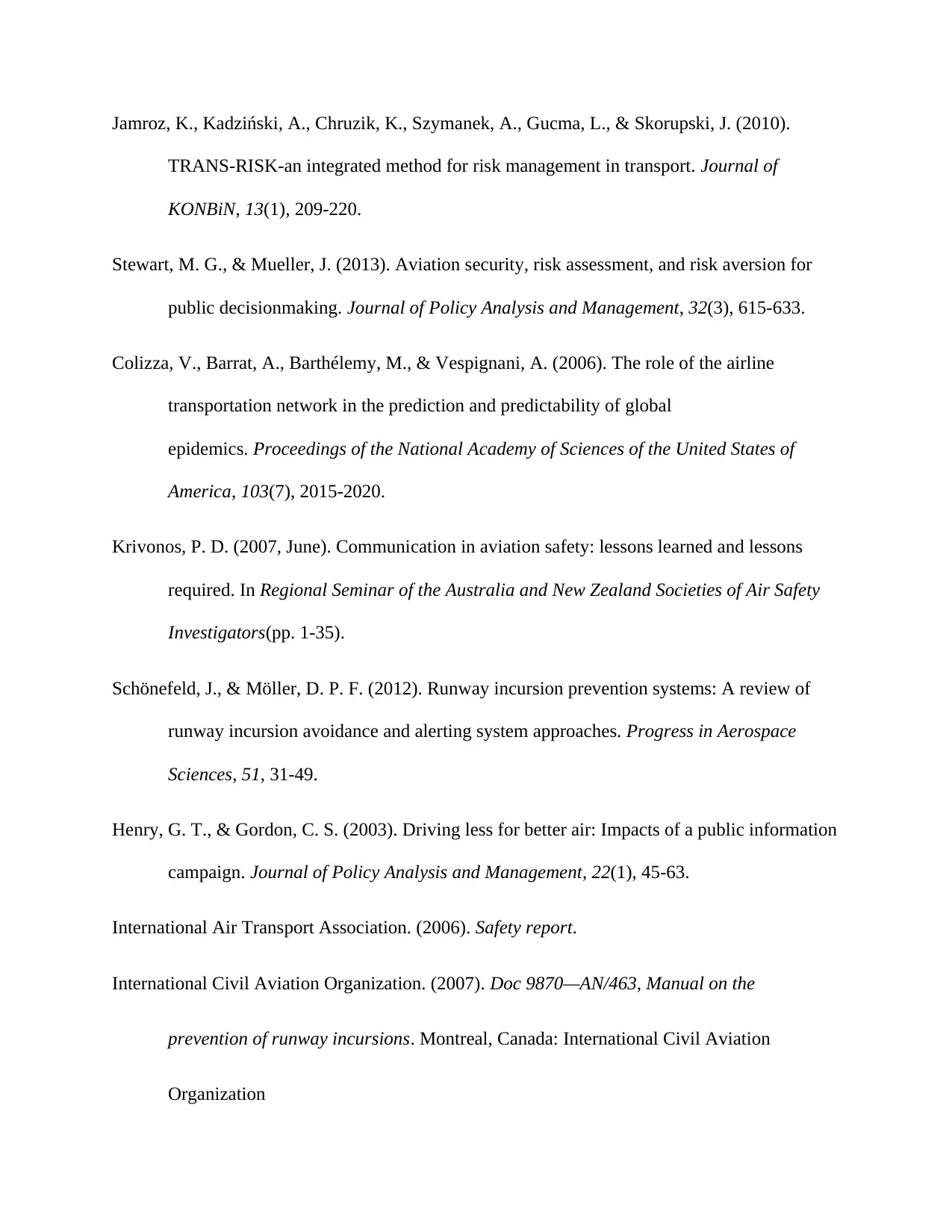
Jamroz, K., Kadziński, A., Chruzik, K., Szymanek, A., Gucma, L., & Skorupski, J. (2010).
TRANS-RISK-an integrated method for risk management in transport. Journal of
KONBiN, 13(1), 209-220.
Stewart, M. G., & Mueller, J. (2013). Aviation security, risk assessment, and risk aversion for
public decisionmaking. Journal of Policy Analysis and Management, 32(3), 615-633.
Colizza, V., Barrat, A., Barthélemy, M., & Vespignani, A. (2006). The role of the airline
transportation network in the prediction and predictability of global
epidemics. Proceedings of the National Academy of Sciences of the United States of
America, 103(7), 2015-2020.
Krivonos, P. D. (2007, June). Communication in aviation safety: lessons learned and lessons
required. In Regional Seminar of the Australia and New Zealand Societies of Air Safety
Investigators(pp. 1-35).
Schönefeld, J., & Möller, D. P. F. (2012). Runway incursion prevention systems: A review of
runway incursion avoidance and alerting system approaches. Progress in Aerospace
Sciences, 51, 31-49.
Henry, G. T., & Gordon, C. S. (2003). Driving less for better air: Impacts of a public information
campaign. Journal of Policy Analysis and Management, 22(1), 45-63.
International Air Transport Association. (2006). Safety report.
International Civil Aviation Organization. (2007). Doc 9870—AN/463, Manual on the
prevention of runway incursions. Montreal, Canada: International Civil Aviation
Organization
TRANS-RISK-an integrated method for risk management in transport. Journal of
KONBiN, 13(1), 209-220.
Stewart, M. G., & Mueller, J. (2013). Aviation security, risk assessment, and risk aversion for
public decisionmaking. Journal of Policy Analysis and Management, 32(3), 615-633.
Colizza, V., Barrat, A., Barthélemy, M., & Vespignani, A. (2006). The role of the airline
transportation network in the prediction and predictability of global
epidemics. Proceedings of the National Academy of Sciences of the United States of
America, 103(7), 2015-2020.
Krivonos, P. D. (2007, June). Communication in aviation safety: lessons learned and lessons
required. In Regional Seminar of the Australia and New Zealand Societies of Air Safety
Investigators(pp. 1-35).
Schönefeld, J., & Möller, D. P. F. (2012). Runway incursion prevention systems: A review of
runway incursion avoidance and alerting system approaches. Progress in Aerospace
Sciences, 51, 31-49.
Henry, G. T., & Gordon, C. S. (2003). Driving less for better air: Impacts of a public information
campaign. Journal of Policy Analysis and Management, 22(1), 45-63.
International Air Transport Association. (2006). Safety report.
International Civil Aviation Organization. (2007). Doc 9870—AN/463, Manual on the
prevention of runway incursions. Montreal, Canada: International Civil Aviation
Organization
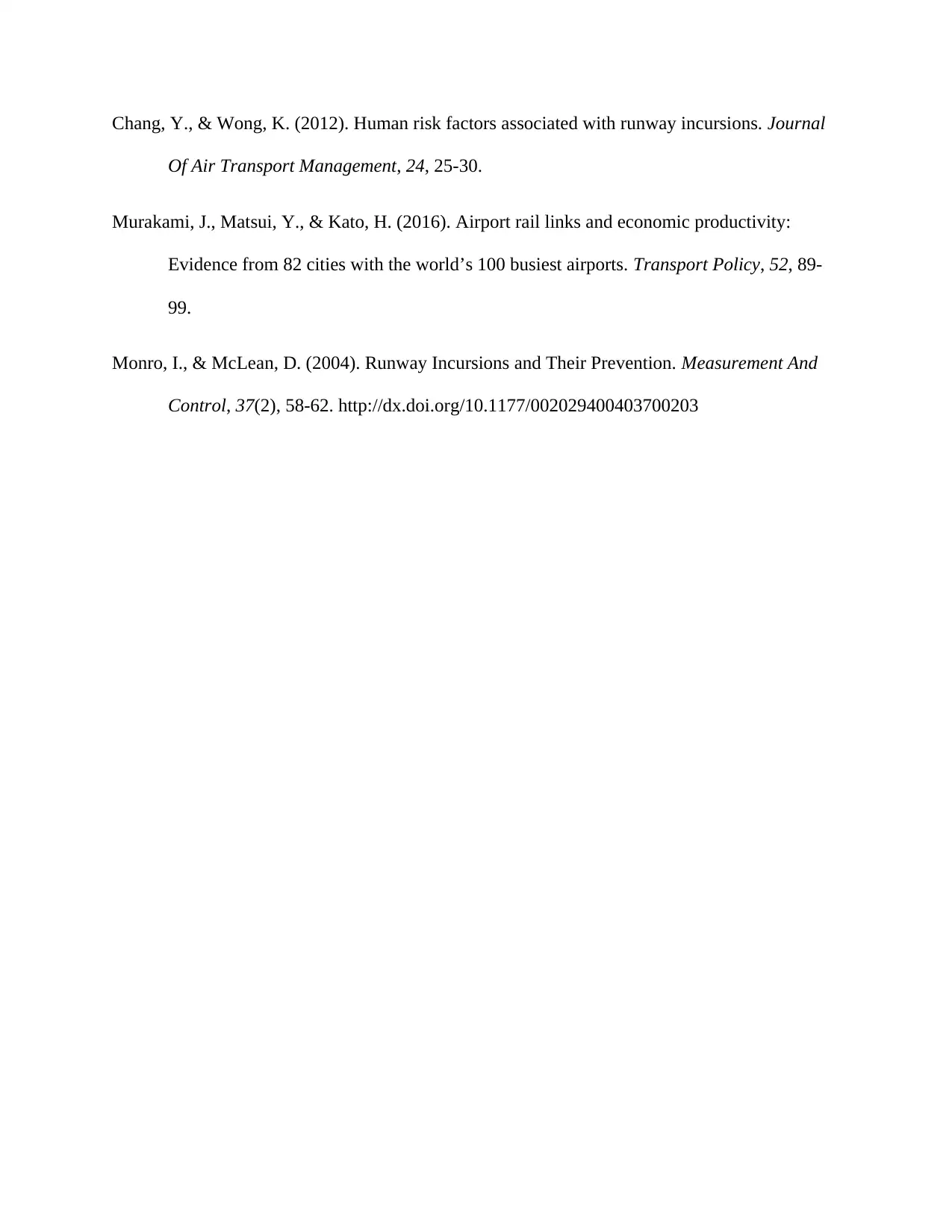
Chang, Y., & Wong, K. (2012). Human risk factors associated with runway incursions. Journal
Of Air Transport Management, 24, 25-30.
Murakami, J., Matsui, Y., & Kato, H. (2016). Airport rail links and economic productivity:
Evidence from 82 cities with the world’s 100 busiest airports. Transport Policy, 52, 89-
99.
Monro, I., & McLean, D. (2004). Runway Incursions and Their Prevention. Measurement And
Control, 37(2), 58-62. http://dx.doi.org/10.1177/002029400403700203
Of Air Transport Management, 24, 25-30.
Murakami, J., Matsui, Y., & Kato, H. (2016). Airport rail links and economic productivity:
Evidence from 82 cities with the world’s 100 busiest airports. Transport Policy, 52, 89-
99.
Monro, I., & McLean, D. (2004). Runway Incursions and Their Prevention. Measurement And
Control, 37(2), 58-62. http://dx.doi.org/10.1177/002029400403700203
1 out of 19
Related Documents
Your All-in-One AI-Powered Toolkit for Academic Success.
+13062052269
info@desklib.com
Available 24*7 on WhatsApp / Email
![[object Object]](/_next/static/media/star-bottom.7253800d.svg)
Unlock your academic potential
© 2024 | Zucol Services PVT LTD | All rights reserved.




